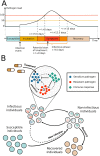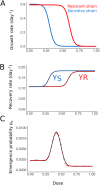Aggressive or moderate drug therapy for infectious diseases? Trade-offs between different treatment goals at the individual and population levels
- PMID: 31404059
- PMCID: PMC6742410
- DOI: 10.1371/journal.pcbi.1007223
Aggressive or moderate drug therapy for infectious diseases? Trade-offs between different treatment goals at the individual and population levels
Abstract
Antimicrobial resistance is one of the major public health threats of the 21st century. There is a pressing need to adopt more efficient treatment strategies in order to prevent the emergence and spread of resistant strains. The common approach is to treat patients with high drug doses, both to clear the infection quickly and to reduce the risk of de novo resistance. Recently, several studies have argued that, at least in some cases, low-dose treatments could be more suitable to reduce the within-host emergence of antimicrobial resistance. However, the choice of a drug dose may have consequences at the population level, which has received little attention so far. Here, we study the influence of the drug dose on resistance and disease management at the host and population levels. We develop a nested two-strain model and unravel trade-offs in treatment benefits between an individual and the community. We use several measures to evaluate the benefits of any dose choice. Two measures focus on the emergence of resistance, at the host level and at the population level. The other two focus on the overall treatment success: the outbreak probability and the disease burden. We find that different measures can suggest different dosing strategies. In particular, we identify situations where low doses minimize the risk of emergence of resistance at the individual level, while high or intermediate doses prove most beneficial to improve the treatment efficiency or even to reduce the risk of resistance in the population.
Conflict of interest statement
The authors have declared that no competing interests exist.
Figures








Similar articles
-
Drug-induced resistance evolution necessitates less aggressive treatment.PLoS Comput Biol. 2021 Sep 23;17(9):e1009418. doi: 10.1371/journal.pcbi.1009418. eCollection 2021 Sep. PLoS Comput Biol. 2021. PMID: 34555024 Free PMC article.
-
Does High-Dose Antimicrobial Chemotherapy Prevent the Evolution of Resistance?PLoS Comput Biol. 2016 Jan 28;12(1):e1004689. doi: 10.1371/journal.pcbi.1004689. eCollection 2016 Jan. PLoS Comput Biol. 2016. PMID: 26820986 Free PMC article.
-
Integrating Antimicrobial Therapy with Host Immunity to Fight Drug-Resistant Infections: Classical vs. Adaptive Treatment.PLoS Comput Biol. 2016 Apr 14;12(4):e1004857. doi: 10.1371/journal.pcbi.1004857. eCollection 2016 Apr. PLoS Comput Biol. 2016. PMID: 27078624 Free PMC article.
-
Antibiotic stewardship in the intensive care unit.Semin Respir Crit Care Med. 2011 Apr;32(2):215-27. doi: 10.1055/s-0031-1275534. Epub 2011 Apr 19. Semin Respir Crit Care Med. 2011. PMID: 21506058 Review.
-
Measuring the impact of antimicrobial stewardship programs.Expert Rev Anti Infect Ther. 2016 Jun;14(6):569-75. doi: 10.1080/14787210.2016.1178064. Epub 2016 May 3. Expert Rev Anti Infect Ther. 2016. PMID: 27077229 Review.
Cited by
-
Nano-Medicines a Hope for Chagas Disease!Front Mol Biosci. 2021 Jun 1;8:655435. doi: 10.3389/fmolb.2021.655435. eCollection 2021. Front Mol Biosci. 2021. PMID: 34141721 Free PMC article. Review.
-
Nanomaterials as Novel Cardiovascular Theranostics.Pharmaceutics. 2021 Mar 7;13(3):348. doi: 10.3390/pharmaceutics13030348. Pharmaceutics. 2021. PMID: 33799932 Free PMC article. Review.
-
A stochastic analysis of the interplay between antibiotic dose, mode of action, and bacterial competition in the evolution of antibiotic resistance.PLoS Comput Biol. 2023 Aug 14;19(8):e1011364. doi: 10.1371/journal.pcbi.1011364. eCollection 2023 Aug. PLoS Comput Biol. 2023. PMID: 37578976 Free PMC article.
-
Nanotechnological strategies for systemic microbial infections treatment: A review.Int J Pharm. 2020 Nov 15;589:119780. doi: 10.1016/j.ijpharm.2020.119780. Epub 2020 Aug 26. Int J Pharm. 2020. PMID: 32860856 Free PMC article. Review.
-
In Vitro Culture of Rosmarinus officinalis L. in a Temporary Immersion System: Influence of Two Phytohormones on Plant Growth and Carnosol Production.Pharmaceuticals (Basel). 2021 Jul 29;14(8):747. doi: 10.3390/ph14080747. Pharmaceuticals (Basel). 2021. PMID: 34451844 Free PMC article.
References
-
- Boucher HW, Talbot GH, Bradley JS, Edwards JE, Gilbert D, Rice LB, et al. Bad bugs, no drugs: no ESKAPE! An update from the Infectious Diseases Society of America. Clinical infectious diseases: an official publication of the Infectious Diseases Society of America. 2009;48(1):1–12. 10.1086/595011 - DOI - PubMed
-
- Centres for Disease Control and Prevention (US). Antibiotic resistance threats in the United States, 2013. Centres for Disease Control and Prevention, US Department of Health and Human Services; 2013.
-
- O’Neill J. Tackling drug-resistant infections globally: final report and recommendations. Review on Antimicrobial Resistance. 2016;.
Publication types
MeSH terms
Substances
LinkOut - more resources
Full Text Sources
Medical

